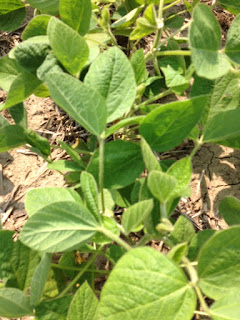Brian and I have been occupied this last week with Y-dropping nitrogen into corn fields. I have been tagging along as part time delivery driver and part time fertilizer rate consultant. It gave me a good chance to evaluate the pros and cons of this application system.
The triangular boot does a nice job of following the corn rows when the corn is waist high or better. One problem with homemade drop lines is keeping them in place while travelling down the row and flopping about on headlands. The Y-Drop stays in place even going across headlands and does not ride up over the rows which minimizes leaf burn from 28% splashing around.
It also performed as advertised by laying two streams of 28% very close to the row.
You can see the twin bands of dribbled nitrogen right beside the corn plants in this picture. The question raised is, are two streams necessary? Could you get away with a drop pipe on every other row? While we didn't actually try it I tend to believe you could. I suppose it would make a difference in some situations, but on our medium soil types I think one stream placed close to the row would be every bit as good as two. One potential issue is whether the nozzle size that came with the system is capable of delivering high rates through half of the drops. Speaking of high rates, applying 40 gal/acre is a slow process with Y-Drops. More fills makes for more tramping on headlands.
Hills and complex topography are the enemy of boom type applicators and that is still the case with Y-Drops. Operator fatigue becomes an issue. We are pretty much flat in these parts, so that particular headache is minimal.
Trying to predict the best nitrogen rate is still just an educated guess. Research published by Bill Deen et.al revealed the optimum N rate for corn could vary by 100 lbs per acre depending on the weather.
According to the paper, 2015 could be a year when higher N rates will pay. We did a selection of nitrogen rate combinations with zero applied strips in a number of fields. The easy part is putting the strips in. The hard part is collecting the harvest data. It will be interesting to see if this approach to nitrogen management has merit. One thing for sure, there has been an explosion of late season nitrogen application this year between sprayers drop piping 28%, high clearance spreaders with urea and even airplanes loaded with urea. For an concept that has never been researched in any great detail here in Ontario, it is getting a baptism by fire in real time.
Thought #2 Roasted Soybeans
It is criminal what we sometimes do to IP soybeans.
These IP beans have been burnt to crisp by post emergence herbicide applications.
It has to happen when weed control from soil applied herbicide goes south, but to an agronomist who promotes plant health at all growth stages it just doesn't feel right. The injury is a necessary part of IP soybean production. You can not afford to let weeds ruin the chance of capturing the IP premiums. Thankfully the soybean most times bounces back from this abuse, producing an acceptable yield. I still have trouble looking at wounded plants and wondering why we do it. I have thought about this in the past and someday would like to do a survey.
Mr & Mrs Urbanite, please answer this question.
Would you want your tofu to be made from a soybean plant that looks like this?
Or would you like to have your tofu made from a soybean plant like this one?
After they made their choice I would reveal the healthy one is a GMO glyphosate tolerant variety that will never look like the plant in the first picture. Then I would ask them to choose again. It would make for great discussion. And maybe lead them to choosing neither. Which would create more discussion.
Thought # 3 Cover Crops - Good News, Not So Good News
Speaking of surveys, Corn Soybean Digest published results of a farmer survey conducted by the Conservation Technology Information Centre on cover crops in the US. This is the third year of the survey. Over 1200 farmers responded, with 84% having planted some type of cover crop.
The top 4 benefits farmers mentioned were
1. Increased soil health - 22%
2. Increased soil organic matter - 20%
3. Reduced soil erosion - 15%
4. Improved weed control - 11%
So far, so good. Cover crop enthusiasts have always touted these as being the main benefits of cover crop use. The assumption is that improving soil health, organic matter etc. will lead to all sorts of manna from heaven and life will be grand.
How about corn and soybean yield response? Increase yield was mentioned by only 2% of producers. The mean yield response following a cover crop was 3.66 bu of corn, or 2.1% and 2.19 bu of soybeans or 4.2%. My calculator tells me that in the year following the cover crop the dollar return to cover crops was $15 - $25 per acre.
I must admit to being disappointed by these results. Cover crop seed and planting expenses can add up quickly. It is not uncommon to have over $30 per acre invested in this endeavor. If the yield response quoted is reality on most farms the cover crop love affair may wilt.. Here in Ontario research has indicated much larger yield responses to be the case, but more work must be done.
No one can argue against concepts that promote soil health. Sometimes the benefits are subtle and under appreciated. We have witnessed the benefits of well rotated, healthy soils that held up to the heavy rain events of this past June. The dollar benefit is difficult to quantify, but we know it is huge.







No comments:
Post a Comment